How giant marine reptiles terrorized the ancient seas
Ichthyosaurs
were some of the largest and most mysterious predators to ever prowl
the oceans. Now they are giving up their secrets.
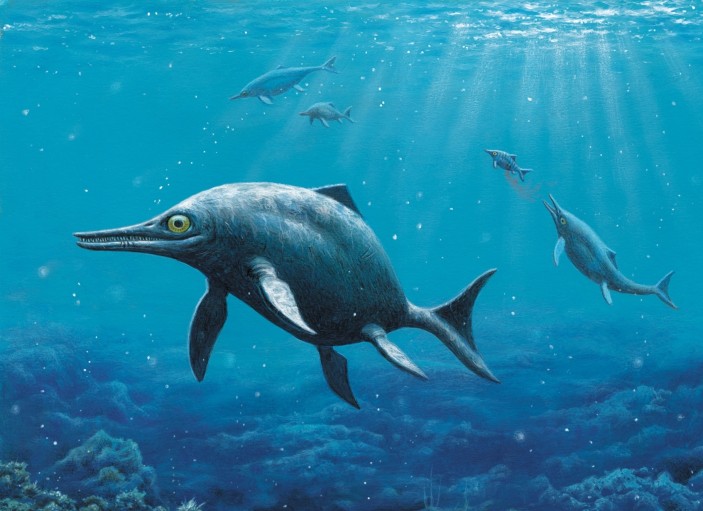
At roughly 9 metres long, Temnodontosaurus platyodon was a giant apex predator from the early Jurassic period.
Credit: Illustration by Esther Van Hulsen
Valentin
Fischer had always wanted to study fossils, perhaps dinosaurs or
extinct mammals. Instead, when he was in graduate school, Fischer ended
up sorting through a pile of bones belonging to ancient marine reptiles
known as ichthyosaurs — a group that had been mostly ignored by modern
palaeontologists. It was not exactly his dream job.
“I said, ‘Ohhh, ichthyosaurs, so boring’,” recalls Fischer. “They all look the same. It’s always a pointy snout and big eyes.”
Fischer
put his feelings aside and dutifully began combing through the fossils
stored in a research centre in provincial France. Among the specimens
stashed in plastic boxes was an ichthyosaur skull that had been
partially destroyed by ants and tree roots while buried underground.
When Fischer cleaned up the skull, he realized that it was probably a
species new to science.
As
discoveries started to pile up, he got hooked. Fischer, now at the
University of Liège, Belgium, and his colleagues have since described
seven surprising new ichthyosaurs, ranging from a tuna-sized reptile
with thin, sharp teeth1 to an animal as big as a killer whale, with a beak like that of a swordfish2.
Fischer
is part of an ichthyosaur renaissance that is sweeping palaeontology.
After ignoring them for decades, more and more researchers have started
to focus on the reptiles, which were among the top predators in the seas
for some 150 million years during the days of the dinosaurs.

Many ichthyosaurs had sharp conical teeth to help them catch fast-moving prey.
Credit: Sinclair Stammers/SPL/Getty
And that
renewed interest has brought a slew of discoveries. In the two centuries
leading up to 2000, researchers identified roughly 80 species of
ichthyosaur and close relatives. In the past 17 years, they’ve added
another 20–30, says vertebrate palaeontologist Ryosuke Motani of the
University of California, Davis, and the number of papers on the animals
has soared.
“There
are more people working on ichthyosaurs right now than I have seen for
my entire career,” says Judy Massare of the State University of New York
College at Brockport, who began studying the animals in the 1980s.
The
swell of research is starting to answer key questions about
ichthyosaurs, such as how and where they originated and how quickly they
came to rule the oceans. The group was even more diverse than once
thought, ranging from early near-shore creatures that undulated like
eels to giants that cruised the open ocean by swishing their powerful
tails. “They could go anywhere, just like whales,” Motani says. The
biggest ones rivalled blue whales (Balaenoptera musculus) in length and were the largest predators in the Triassic seas.
The
work is also revealing the last chapters of the ichthyosaur story,
which culminated with the animals’ extinction during the Upper
Cretaceous, some 30 million years before dinosaurs disappeared. Some
scholars now argue that the ‘fish-lizards’ were vanquished in part by
the era’s drastic environmental shifts. That’s a form of redemption for
ichthyosaurs; an old theory had suggested that they vanished when more
capable predators, such as swift sharks, emerged and eclipsed them.
And
palaeontologists point to one more reason to focus on ichthyosaurs:
because their distant ancestors were land reptiles, the creatures offer a
particularly dramatic example of one of the biggest evolutionary
makeovers evident in the fossil record, says vertebrate palaeontologist
Stephen Brusatte of the University of Edinburgh, UK. “They totally
changed their bodies, biologies and behaviours in order to live in the
water.”
Fishy start
The
word ‘dinosaur’ hadn’t even been coined when a weird skeleton appeared
along the southwestern English coast in the early nineteenth century.
The bones caught the eyes of celebrated fossil hunter Mary Anning, then
no older than 13, and her brother. Their fossil fetched them £23, a
substantial sum at the time, and inspired the first scientific paper3
devoted to ichthyosaurs. The paper, published by British surgeon
Everard Home in 1814, erroneously called the animal a “fish … not of the
family of sharks or rays”. Other naturalists soon recognized the
fossils as reptiles.
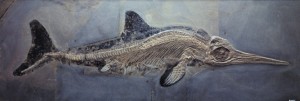
Like many later ichthyosaurs, Stenopterygius quadriscissus lived in the open ocean. Black marks around fossil show the outline of the preserved skin.
Credit: Field Museum Library/Getty
The leading
lights of natural history marvelled at these creatures. Frenchman
Georges Cuvier, considered the father of vertebrate palaeontology,
called them “incredible”, and held up ichthyosaurs as support for his
theory that catastrophic mass extinctions have plagued Earth. British
geologist Charles Lyell, meanwhile, suggested that ichthyosaurs could
reappear when Earth’s climate cycled through a favourable phase.
Then
came the discovery of monstrous land animals, many of which were armed
with rows of fierce teeth. This group, named dinosaurs, captivated the
public and scientists alike. According to Fischer, they “kicked
ichthyosaurs off the pedestal of glory”. The fossils of the marine
reptiles piled up unstudied in museums, and their life story was left
incomplete.
Today’s
renaissance in ichthyosaur research is filling in the gaps, especially
the fish-lizards’ origins. It took massive anatomical change to mould
fully aquatic animals out of land reptiles. Their arms shrank and their
hands enlarged, forming seaworthy flippers. They developed the ability
to hold their breath for long stretches, even up to 20 minutes. Many
evolved huge eyes — larger than footballs, in one species — for peering
through the dark depths.
Researchers
suspect that those changes took place not long before or after an
apocalyptic mass extinction that wiped out 80% of Earth’s marine species
at the end of the Permian period4. But until the past few years, they have lacked fossils to illustrate much of that transition.
One
of the early forms helping to fill in that gap is an animal that Motani
calls “the most bizarre” early ichthyosaur ever seen, which he and his
colleagues discovered in a Chinese limestone quarry5. It had a head the size of an orange and a torso encased by wide slabs of bone, earning it the scientific name Sclerocormus parviceps,
or ‘stiff-trunk small-skull’. It dates to 248 million years ago, only 4
million years after the end-Permian extinction. A nearby quarry yielded
a snub-nosed fish-lizard of roughly the same age, Cartorhynchus lenticarpus6. About as long as a rainbow trout (Oncorhynchus mykiss),
this primitive ichthyosaur may have heaved itself around on land atop
its big flippers in much the same way that sea turtles do.
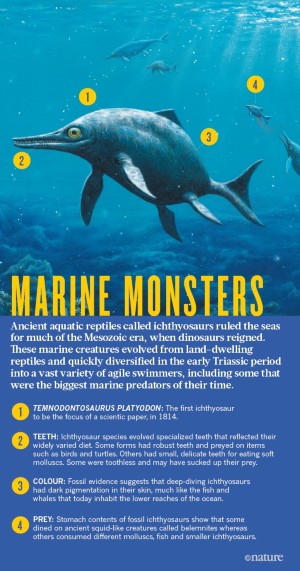
Credit: Illustration by Esther Van Hulsen
These early
animals weren’t direct ancestors of the fish-shaped ichthyosaurs. But
they are still “a big step forward in understanding where ichthyosaurs
came from”, says Erin Maxwell, a palaeontologist at the Stuttgart State
Museum of Natural History in Germany. The fossils show, for example,
that ichthyosaurs originated in what is now the eastern part of south
China. At the time, it was one of the few places in the world where land
plants flourished. Decaying vegetation would have enriched the nearby
seas, Motani says, and eventually, “seafood looked attractive to animals
that happened to live near the coastline”.
The land-worthy flippers of Cartorhynchus led
Motani to argue that it had recent ancestors that were terrestrial, or
at least amphibious. That would make it a close relative of the
land-based or amphibious ancestor of all ichthyosaurs. He interprets the
heavy bones of both Sclerocormus and Cartorhynchus as
evidence of a bottom-dwelling lifestyle. Other animals that moved from
land to sea also went through a bottom-dwelling phase, Motani says, and
with his new finds, “we have proof that ichthyosaurs went through that
heavy stage, and were most likely bottom feeders” — unlike the later
ichthyosaurs, which were creatures of the open ocean.
Other
researchers agree that the Chinese fossils provide a valuable window
into the transformation from landlubber to sea creature. The discoveries
are “some of the most interesting reptile fossils that have been found
recently”, Brusatte says. “They are giving us a glimpse of what it
actually took to turn a land-living reptile into something semi-aquatic
and then something that looked like a fish.”
Proper
ichthyosaurs, which boast long snouts and kinked tails to distinguish
them from their primitive forebears, appeared during the early Triassic
and quickly took over their new environment. Discoveries over the past
few years have revealed the wide variety of fish-lizards that emerged at
the same time as Cartorhynchus or soon after.
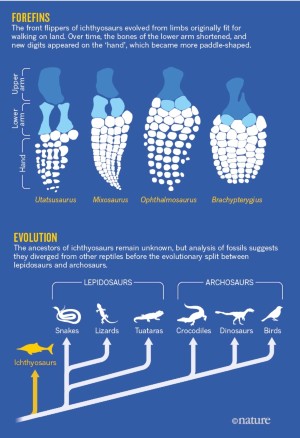
Credit: Adapted from Ryosuke Motani.
Take the killer-whale-sized Thalattoarchon saurophagis, or ‘lizard-eating ruler of the seas’, which was spotted in Nevada 20 years ago but not fully excavated7
until 2008. Its sharp teeth reveal it as a “large meat-eater or
flesh-tearer” that preyed on fish and other ichthyosaurs, says
vertebrate palaeontologist Martin Sander of the University of Bonn in
Germany and the Natural History Museum of Los Angeles County, who helped
to describe the animal. During its reign in the early Middle Triassic,
only 8 million years after the end-Permian extinction, it “basically ate
anything it wanted to”, Sander says.
On
Norway’s Spitsbergen Island north of the Arctic Circle, researchers
have hacked away the permafrost to reveal large, primitive ichthyosaurs
that seem to date to the very early Triassic. The finds have yet to be
identified, but they help to show that “once these things hit the water,
they just went nuts”, says Patrick Druckenmiller, a palaeontologist at
the University of Alaska Fairbanks and part of the Spitsbergen team. The
presence of large predators at this time suggests that creatures of all
sizes and lifestyles restocked the oceans after the devastation of the
end-Permian extinction.
After
their initial burst of evolution, ichthyosaurs went through some tough
times. In the later Triassic, many species died out during one or more
mass extinctions that also claimed large fractions of species on land
and in the oceans.
After
this, the ichthyosaur’s story gets complicated. Palaeontologists had
long thought that the group was hit by a major loss of biodiversity in
the Jurassic and never really recovered. The fossil record suggested
that only a handful of species, all similar in appearance and lifestyle,
limped across the Jurassic–Cretaceous boundary 145 million years ago.
Then the whole group went extinct midway through the Cretaceous, while
dinosaurs thrived for another 30 million years or so, until an asteroid
strike wiped them out. The lack of diversity among ichthyosaur species
could have hampered their ability to compete against sharks and other
emerging predators in the seas.

Credit: Swimming styles adapted from Ryosuke Motani.
But finds
in the past few years have called that whole story into question. New
fossil discoveries show that many more species thrived during the
Cretaceous than previously recognized. These species also had more
diverse body types and food sources than researchers thought.
Ichthyosaurs’
reputation has risen in good part because of Fischer’s work — not at
sweaty dig sites but in hushed museums. “I am very bad at finding
fossils in the field,” Fischer confesses. “The only ichthyosaur I’ve
found, ever, is a single vertebra.” But the hundreds of museum specimens
that he has scrutinized — some of them left unexamined for a century —
have yielded a bounty of Cretaceous novelties. In just over a decade,
Fischer’s team and other groups have reported at least nine new species
from this period.
Fischer
and his colleagues estimate that the number of known ichthyosaur
species was just as high during parts of the early Cretaceous as during
spans of the Jurassic. It turns out that the fish-shaped reptiles called
parvipelvians, the only group of ichthyosaurs to endure from the
Triassic into the Cretaceous, had a greater range of shapes during the
middle of the early Cretaceous than at any other time in their history8.
“The diversity of ichthyosaurs in the Cretaceous, in particular, is
even higher than we ever thought it was”, says Fischer’s co-author
Darren Naish, a vertebrate palaeontologist at the University of
Southampton, UK. He calls it a “Cretaceous ichthyosaur revolution”.

Credit: ILLUSTRATIONS BY ESTHER VAN HULSEN
Then,
according to Fischer’s analysis, a one-two punch hit the ichthyosaurs. A
good number of species went extinct roughly 100 million years ago, and
the few survivors followed their relatives some 5 million to 6 million
years later. To understand why, Fischer looked to environmental factors.
He noticed a correlation between climate and extinctions: the greater
the temperature fluctuation in a given period, the more species of
ichthyosaurs winked out.
Other
scientists agree that climate disruptions could have played a big part
in the animals’ disappearance. Climate volatility “is a much better
hypothesis than any proposed so far. It matches what we know about
extinction risk in large predators today,” Maxwell says.
The
mid-Cretaceous was a difficult time in the oceans. Ichthyosaurs died
out when sea levels were high and marine oxygen levels were low. Many
other ocean groups, such as ammonites, were going downhill fast during
the same period. Ichthyosaurs, then, might be “just a small facet of
something more important”, Fischer says. He’s now looking at whether
other marine predators during the Cretaceous followed the ichthyosaur
pattern.
Fischer’s
results are not universally accepted. Motani, for example, thinks that
Fischer’s scenario is plausible, but he takes issue with the statistical
methods that Fischer uses to date ichthyosaurs’ extinction. Fischer
places the reptiles’ disappearance close to 94 million years ago, but if
the creatures went extinct at a different time, the correlation between
their fate and climate volatility would not be as strong. Fischer
stands by his conclusions, however, and says that the fossil record for
marine reptiles actually improves during the Cretaceous, which adds
confidence to conclusions about ichthyosaurs during that period.
The
debate over ichthyosaurs’ final days will continue to rage, as
scientists strive to understand the forces behind the mysterious
extinction of a successful group. Researchers also hope to understand
what befell the ichthyosaurs that died out at the end of the Triassic.
More fossils would help. So would techniques that have already been
deployed to better date the sediments containing ichthyosaurs, enabling
researchers to pinpoint species’ histories with higher precision.
The
new debates and competition characterizing the field do not perturb
Motani. He has no yearning for the lonely days when he was one of so few
ichthyosaur specialists that journals struggled to peer-review his
manuscripts. On the contrary, he is glad that more scientists are
pursuing the animals he regards as “beautiful, and beautifully adapted”.
To Motani and other partisans, ichthyosaurs are finally getting the
attention they’ve long deserved.
References
- 1Fischer, V., Masure, E., Arkhangelsky, M. S. & Godefroit, P. J. Vertebr. Paleontol. 31, 1010–1025 (2011).
- 2Martin, J. E., Fischer, V., Vincent, P. & Suan, G. Palaeontology 55, 995–1005 (2012).
- 3Home, E. Phil. Trans. R. Soc. Lond. 104, 571–577 (1814).
- 4Stanley, S. M. Proc. Natl Acad. Sci. USA 113, E6325–E6334 (2016).
- 5Jiang, D.-Y. et al. Sci. Rep. 6, 26232 (2016).
- 6Motani, R. et al. Nature 517, 485–488 (2015).
- 7Fröbisch, N. B., Fröbisch, J., Sander, P. M., Schmitz, L. & Rieppel, O. Proc. Natl Acad. Sci. USA 110, 1393–1397 (2013).
- 8Fischer, V., Bardet, N., Benson, R. B., Arkhangelsky, M. S. & Friedman, M. Nature Commun. 7, 10825 (2016).
Author information
Affiliations
Related links
Related links
Related links in Nature Research
Swimming dinosaur found in Morocco 2014-Sep-11Kraken versus ichthyosaur: let battle commence 2011-Oct-11
Did reptile swimmer show mother love? 2011-Aug-11
Ichthyosaurs ate turtle soup 2003-Jul-23
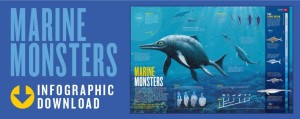
Nenhum comentário:
Postar um comentário
Observação: somente um membro deste blog pode postar um comentário.